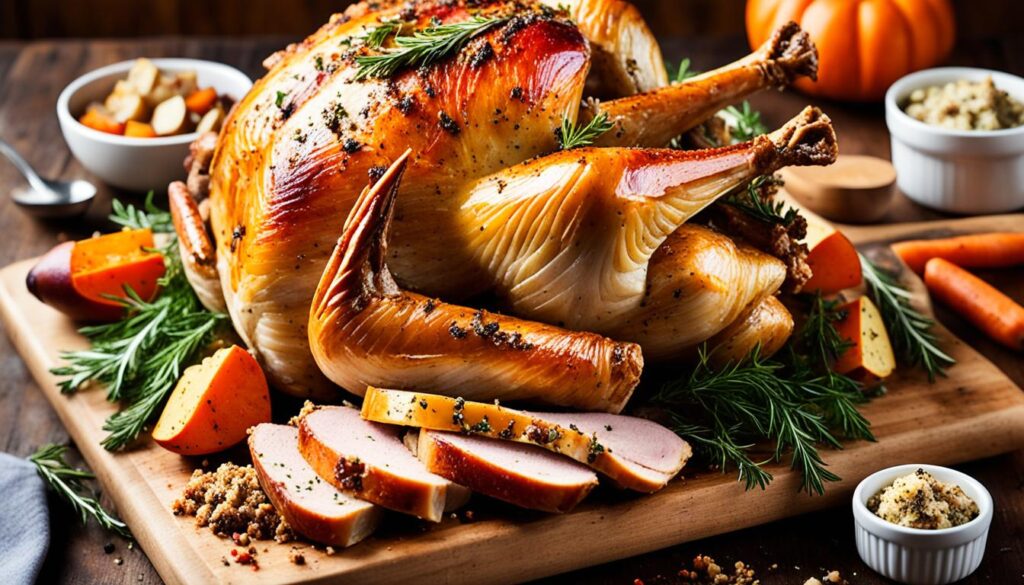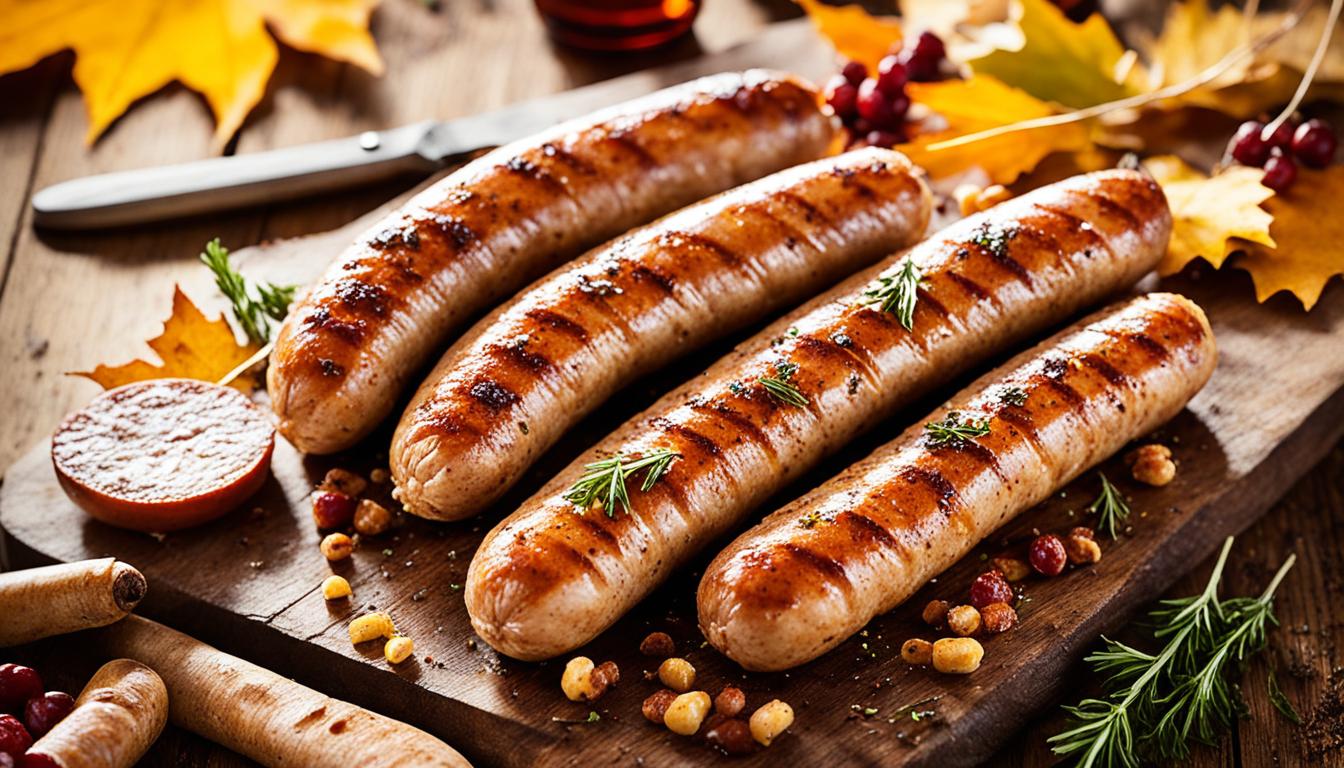Are you looking for a unique and flavorful twist to add to your Thanksgiving feast? Why not try making homemade weisswurst turkey sausages? This delicious recipe, inspired by the traditional German sausage, combines the rich flavors of turkey, lemon zest, mace, and parsley for a mouthwatering treat that will impress your guests.
Making weisswurst turkey sausages is easier than you might think, and you don’t need any special equipment. With a little extra care and attention to detail, you can create juicy and flavorful sausages that will elevate your Thanksgiving meal to a whole new level.
In this article, we will explore the importance of salt and fat in sausage making, the role of cold temperatures in emulsified sausages, and even provide you with a unique French-inspired stuffed turkey recipe by renowned author Paula Wolfert. So, are you ready to take your Thanksgiving feast to new heights? Let’s get started!
Key Takeaways
- Weisswurst turkey sausages are a unique and delicious addition to your Thanksgiving meal.
- Salt plays a crucial role in sausage making, enhancing flavor and improving moisture retention.
- The right fat-to-lean ratio is essential for juicy and flavorful sausages.
- Cold temperatures are important in emulsified sausages to achieve a stable texture.
- Try a French-inspired stuffed turkey recipe for a unique twist on your Thanksgiving feast.
The Importance of Salt in Sausage Making
Salt plays a crucial role in sausage making, influencing both the texture and flavor of the final product. When salt is added to meat, it creates a salty brine by dissolving in the meat juices. This brine interacts with certain proteins in the meat, such as myosin, causing them to partially dissolve. As a result, the protein bundles in the meat loosen, leading to better binding and moisture retention in the sausage.
The dissolved proteins help the sausage hold on to its moisture during cooking, preventing it from becoming dry or mealy. In order to maximize the sausage’s moisture retention abilities, it’s essential to allow the meat to rest after salting. This resting period allows the salt to fully dissolve and the proteins to further dissolve and create a more stable structure.
For proper sausage binding, it is recommended to salt the meat in advance of mixing. A suitable guideline is to use a ratio of 1.5 to 2% salt compared to the mass of the meat. This ensures that the salt is evenly distributed and thoroughly incorporated into the sausage mixture.
“Salt is essential in sausage making as it enhances moisture retention, binding, and flavor. By salting the meat in advance and allowing it to rest, we can achieve a perfectly textured and flavorful sausage.”
In addition to its impact on texture and binding, salt also plays a vital role in enhancing the flavor of sausages. It helps to draw out and intensify the natural flavors of the meat, creating a more savory and delicious sausage.
Overall, the importance of salt in sausage making cannot be overstated. It contributes to proper binding, moisture retention, and flavor development, resulting in sausages that are both delicious and enjoyable. By understanding the role of salt in the sausage-making process, we can achieve sausages that have the perfect texture, bind well, and are bursting with flavor.
Effects of Salt on Meat Texture and Flavor
| Texture | Effect of Salt |
|---|---|
| Tenderness | Loosens protein bundles, resulting in a softer texture |
| Moisture Retention | Creates brine that dissolves proteins and enhances moisture retention |
| Binding | Improves binding by dissolving proteins and creating a more stable structure |
| Flavor | Effect of Salt |
|---|---|
| Savoriness | Enhances natural flavors of the meat |
| Depth | Intensifies the overall flavor profile of the sausage |
Note: The image above visually represents the importance of salt in sausage making.
By understanding the effects of salt on meat texture and flavor, we can optimize our sausage recipes to create perfectly seasoned and delicious sausages.
The Role of Fat in Sausage Making
Fat plays a crucial role in sausage making, contributing to both juiciness and flavor. Without fat, sausages can be dry and lacking in taste. The ideal fat content in sausages is around 35%, striking a balance between moistness and texture.
When fat is present in the sausage, it softens and liquefies during cooking, enhancing juiciness and mouthfeel. However, too much fat can lead to overly soft and greasy sausages. Pork fat is often the preferred choice for sausages due to its neutral flavor, softening properties, and melting temperature.
Poultry fat is not recommended for emulsified sausages as it can be difficult to emulsify properly and tends to liquefy at low temperatures. Ruminant animal fats like beef and lamb are high in saturated fats, making them hard and waxy even when heated, resulting in a greasy mouthfeel.
By using the right amount and type of fat in sausages, you can achieve a balance of juiciness and flavor for your Thanksgiving turkey sausage recipe.
Importance of Fat-to-Lean Ratio
The fat-to-lean ratio is an important factor to consider when making sausages. This ratio determines the overall texture and moisture content of the sausages.
In general, a higher fat content results in a juicier sausage with a smoother mouthfeel. However, it’s essential to strike the right balance and avoid excessive fat, which can lead to greasy sausages.
| Fat-to-Lean Ratio | Texture | Moisture Content |
|---|---|---|
| High Fat Content | Smooth and Tender | Moist |
| Lower Fat Content | Firmer | Drier |
When determining the fat-to-lean ratio, keep in mind that sausages with too little fat can become dry and lack flavor, while those with too much fat can be excessively greasy. Aim for a balanced ratio to achieve the perfect texture and moisture level in your sausages.
Ideal Fat Content for Sausages
For most sausages, including turkey sausages, the ideal fat content is around 35%. This percentage allows for optimal juiciness and flavor without compromising the texture.
By maintaining the recommended fat content, you can ensure that your sausages are moist, succulent, and full of flavor. It’s important to note that different types of sausages may have specific fat requirements, so it’s essential to refer to a trusted recipe or expert guidance for precise fat content recommendations.
Keeping Ingredients and Equipment Cold for Emulsified Sausages
In the process of making emulsified sausages like weisswurst turkey sausages, keeping the ingredients and equipment cold is crucial for achieving a stable emulsion.
Emulsions are homogenous mixtures of two substances that don’t typically mix well, such as fat and water. In sausage making, emulsions are formed by breaking up fat droplets so finely that they are completely surrounded by water molecules. This prevents them from coalescing and ensures a smooth texture.
Cold temperatures help stabilize the emulsion, as emulsions are temperature-dependent. When preparing emulsified sausages, it’s important to grind the meat and fat while they are cold to prevent smearing and to maintain the desired texture.
Additionally, the stability of the emulsion itself is dependent on the temperature at which it is formed. If the emulsion gets too warm during grinding or mixing, the fat droplets can start to coalesce, resulting in a broken and grainy texture.
Importance of Cold Temperatures
“Maintaining cold temperatures throughout the sausage making process is essential for achieving a stable emulsion. Cold temperature helps prevent fat from melting and ensures that the fat droplets stay finely dispersed in the water-based mixture. This results in a smooth and cohesive texture in the final sausages.”
To keep the ingredients and equipment cold, it’s recommended to:
- Chill the meat and fat in the freezer before grinding.
- Place the grinding equipment in the freezer for some time before use.
- Keep the mixing bowl and paddles refrigerated.
- Work in a cool environment to prevent heat transfer.
By understanding the importance of cold temperatures in emulsified sausage making, you can achieve a perfectly emulsified and stable texture in your Thanksgiving turkey sausages.
Next, let’s explore the role of salt in sausage making and how it enhances the flavor and texture of the sausage.
Stuffed Young Turkey Auvergne Style Recipe
For a unique and indulgent Thanksgiving turkey recipe, you can try the Stuffed Young Turkey Auvergne Style recipe by famed author Paula Wolfert. This recipe combines the flavors of sautéed mushrooms, prosciutto, walnuts, white sausage, and a variety of other ingredients for a flavorful stuffing. The stuffing is also used to fill onion layers, creating football-shaped packets that are cooked alongside the roasting turkey. The result is a deliciously complex and impressive presentation that will impress your guests.
While this recipe may require some extra effort and preparation, the final result is well worth it. Whether you choose to stick with the traditional weisswurst turkey sausages or try this French-inspired turkey recipe, both options will add a unique twist to your Thanksgiving feast.

This Stuffed Young Turkey Auvergne Style recipe combines:
- Sautéed mushrooms
- Prosciutto
- Walnuts
- White sausage
“The stuffing is also used to fill onion layers, creating football-shaped packets that are cooked alongside the roasting turkey.”
With these flavorful ingredients, the Stuffed Young Turkey Auvergne Style recipe offers a unique twist on the traditional Thanksgiving turkey. Impress your family and friends with this indulgent and delicious dish that will elevate your holiday feast to a whole new level.
Recipe:
| Ingredients | Quantity |
|---|---|
| Sautéed mushrooms | 1 cup |
| Prosciutto | 1/2 cup |
| Walnuts | 1/2 cup |
| White sausage | 1/2 cup |
…
The rest of the recipe can continue here.
Elevate Your Thanksgiving Feast with Homemade Weisswurst Turkey Sausages
Add a homemade twist to your Thanksgiving feast by incorporating delicious weisswurst turkey sausages. Whether you decide to follow the traditional weisswurst recipe or experiment with the unique Stuffed Young Turkey Auvergne Style recipe, both options will bring a burst of flavor and a homemade touch to your holiday table.
Understanding the significance of salt and fat in sausage making is key to creating moist, flavorful sausages that are perfectly suited for your Thanksgiving celebration. By carefully controlling the fat-to-lean ratio and adding the right amount of salt, you can achieve a delectable balance of juiciness and taste.
Don’t forget to maintain cold temperatures throughout the sausage-making process. Cold ingredients and equipment are essential for creating stable emulsions and ensuring the desired texture in your weisswurst turkey sausages. Take this opportunity to try new and exciting recipes, impressing your guests and establishing a new Thanksgiving tradition.
Elevate your Thanksgiving feast this year with homemade weisswurst turkey sausages. Combine the warmth of a home-cooked meal with the unique flavors of sausages, adding that extra touch of love and creativity to your holiday spread. Your guests will be delighted by the Thanksgiving twist and impressed by your culinary skills as they savor the delectable results.
